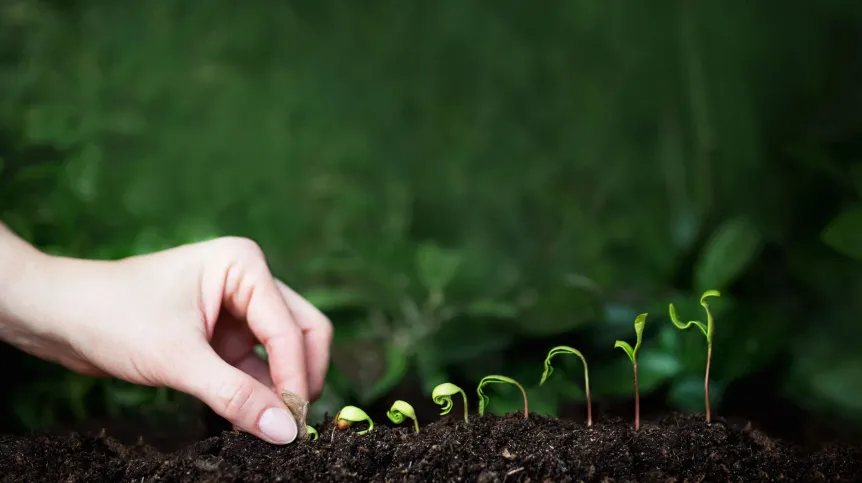
Light pollution affects not only humans, but also - very strongly - plants. It disrupts their growth, flowering and immunity, which affects ecosystems, crops and food production. Meanwhile, this is a problem that can be partially relatively easily reduced, scientists believe.
Although plants do not move like animals, they are not passive to the world around them. They carefully 'catch' signals from the environment, including light, which plays a key role in their lives. For millions of years, these organisms have developed in rhythm with sunrises and sunsets.
However, in recent decades, light pollution, or the presence of artificial lighting in the environment at night, has become an increasingly serious problem. This is light that 'escapes' from streetlights, houses, offices, advertisements and illuminated buildings.
Many studies on the impact of light pollution on humans have shown that it disrupts sleep, circadian rhythm, promotes many diseases and mental disorders. In the case of plants, the subject is still poorly researched. In Poland, it is being studied, among others, by Anna Kołton, PhD, a professor at the Department of Botany, Physiology and Plant Protection of the University of Agriculture in Krakow.
The scientist explains in an interview with PAP that plants are sensitive to a wide range of radiation - not only the range visible to the human eye (between 400 and 700 nm), but also ultraviolet and infrared radiation. They react to it thanks to the presence of photoreceptors, which can be divided into two groups: some receive light as energy, others as information. The first group enables photosynthesis, the second allows the plant to 'orient itself' in time and space and adapt its development to it.
'Light is information for a plant about what is happening, where it is, what time of day and year it is. It reacts to all this and, based on even small changes in the intensity and spectral composition of light, knows when to start initiate processes (e.g. in the morning) and when to end them (e.g. in the evening). Light therefore changes its metabolism, growth, development; it affects whether it will flower, whether it will start aging processes, etc. The problem begins when artificial light is added to natural light at night', Kołton says.
JShe adds that artificial light sources usually fall within the range of radiation to which plants are particularly sensitive. Therefore, there should be very little of it at night. 'The point is not that there being none at all, because we also have starlight and light reflected from the moon. However, in recent years its amount has increased so much that the natural processes of plants have been disrupted; their day and night cycle', the researcher emphasises.
There are situations in which photoreceptors receive light signals almost all the time, so plants start to react as if it was daytime, or as if the day did not change regardless of the season. This means that processes such as growth inhibition and preparation for dormancy, slowing down photosynthesis or changing the position of leaves do not start in time. This results in metabolic disorders, changes in the rate of growth, disorders in flowering and ripening, as well as changes in the structure of organs such as leaves.
Studies show that artificial light at night can affect the shape of cells, the thickness of tissues and even the activity of stomata - microscopic structures responsible for gas exchange. Instead of closing at night, they can remain open, which leads to unnecessary water loss. In cities, where plants are often not properly watered, this leads to their faster withering and death.
JAccording to Kołton, one of the most visible and most serious effects of light pollution are changes in plant phenology, i.e. the seasonal rhythm of their development. 'For example, they grow leaves and flowers earlier. This may seem harmless at first glance - after all, we will see beautiful signs of spring sooner. But if the development of plants is not synchronized with the temperature, frosts can destroy leaves or buds that have developed too early. What's more, if flowers appear earlier than the insects that pollinate them, serious disorders in plant reproduction and entire ecosystems can occur', she says.
A similar thing happens when, due to the high availability of night lighting, the entry into winter dormancy is delayed, which makes the plant less resistant to frost.
The impact of light on plants does not end with development processes. It is also related to their health. A too long day, i.e. an extended photoperiod, can cause the stress syndrome in plants, leading to metabolic disorders, improper enzyme function, and even cellular damage. During photosynthesis, reactive oxygen species are created - molecules that can be harmful in excess. Night is a time for plants to 'neutralize' them. However, if light acts continuously, toxic molecules can accumulate, causing damage.
The complicated relationship between plants and light is well illustrated by the lighting of crops, e.g. in greenhouses. 'In autumn and winter, when crops do not grow in the ground in our latitude, we introduce artificial lighting, which simulates a longer day and provides the energy needed for photosynthesis. At some point, the idea came up to illuminate them 24 hours a day, which would increase yields. But it quickly turned out that it did not work. The 24-hour supply of light caused a decrease in yields, chlorosis (yellowing of leaves) and leaf damage. Therefore, currently, even in intensive cultivation, lighting is used for a maximum of a dozen or so hours, leaving the plant time for +night rest+', the biologist explains. 'And unfortunately, the level of light pollution that we currently experience introduces such 24-hour lighting into the world of plants', she adds.
Light pollution is therefore, next to climate change, drought and air pollution, another stress factor that negatively affects plant life. However, of all the above, it is relatively the easiest to eliminate. 'We will not stop global warming in one move, but we can simply turn off some of the light at night. Or at least reduce its emission where it is not needed. This is a simple action that can bring real benefits. Unfortunately, the hardest thing is to want to do it. So we have to start with knowledge and raising awareness', Kołton says.
In her opinion, first of all, we should limit the number of illuminated street advertisements, but we can also turn off streetlights in parks at night, install motion sensors in housing estates, direct the light stream down onto pavements and roads, not onto trees and flower beds, use lower intensity and narrower beams of light, and choose lamps with a warm colour, and avoid cold, white LEDs. However, the basis for these actions must be educating the public. 'We really like using light in large quantities, but not everything we like is positive. Sometimes we have to think about what the further consequences will be', she says.
In the case of light pollution, the consequences are very serious. They include lower biomass production, shorter plant life, greater brittleness, susceptibility to frost and diseases. Many species also lose their decorative properties, and some may even disappear, leading to impoverishment of biodiversity and disruption of the balance of ecosystems.
'I, too, believe that certain things should be illuminated at night. But we can do it more sensibly - when and where it is really needed, and in the right way', the scientist concludes.
Katarzyna Czechowicz (PAP)
kap/ bar/ mhr/













